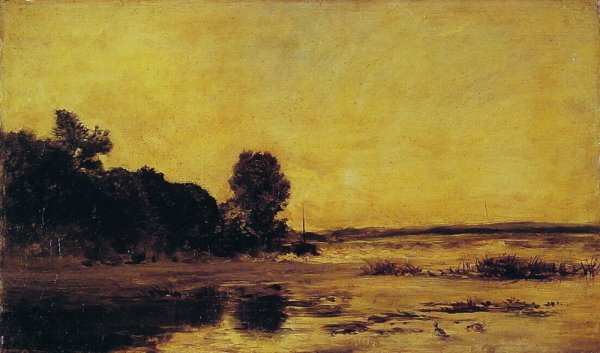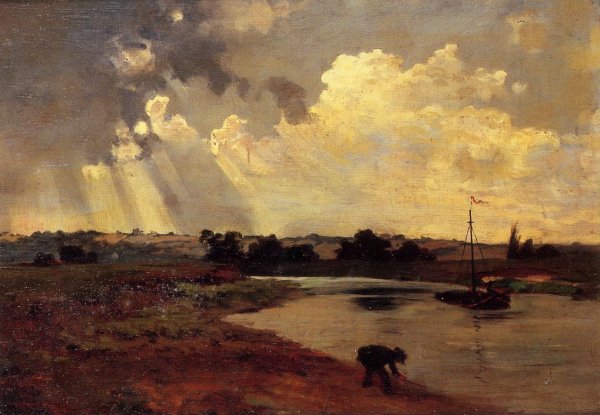Charles-Francois Daubigny Biography In Details
Life

Charles-Francois Daubigny in 1866 Daubigny visited England, eventually returning because of the Franco-Prussian war in 1870. In London he met Claude Monet, and together they left for the Netherlands. Back in Auvers, he met Paul Cézanne, another important impressionist. It is assumed that these younger painters were influenced by Daubigny.
Daubigny's finest pictures were painted between 1864 and 1874 , and these for the most part consist of carefully completed landscapes with trees, river and a few ducks. It has been said that when Daubigny liked his pictures he added another duck or two, so that the number of ducks often indicates greater or less artistic quality in his pictures.[citation needed] One of his sayings was, "The best pictures do not sell," as he frequently found his finest achievements little understood. Daubigny is chiefly preferred for his riverside pictures, of which he painted a great number, but although there are two large landscapes by Daubigny in the Louvre, neither is a river view. They are for that reason not so typical as many of his smaller Oise and Seine pictures.
His most ambitious canvases are: Springtime (1857), in the Louvre; Borde de la Cure, Morvan (1864); Villerville sur Mer (1864); Moonlight (1865); Auvers-sur-Oise (1868); and Return of the Flock (1878).
His followers and pupils were his son Karl (who sometimes painted so well that his works are occasionally mistaken for those of his father, though in few cases do they equal his father's mastery), Oudinot, Delpy, Albert Charpin and Damoye. (From Wikipedia)
Complete Biography

Charles Daubigny was born in Paris on Feb. 15, 1817. His father, Edmé François Daubigny, was a landscape painter, and his uncle and aunt were miniaturists. Daubigny made the customary trip to Italy (1835-1836) and did some ideal landscapes, but his eventual direction was more decisively shaped by Dutch landscape painting. In 1838 he enrolled as a student of the academic painter Paul Delaroche.
Although Daubigny enjoyed a reasonable success at the Salons, where he exhibited from 1838 on, graphic art in the form of etchings, woodcuts, lithographs, and illustrations contributed substantially to his income. Pond with Storks (ca. 1851), with its painstaking analytical detail, is a representative Barbizon school work; it also echoes Dutch art of the 17th century. Some of Daubigny's rarely seen drawings, such as River Landscape (ca. 1860), have an astonishingly light, airy, and evocative touch.
Daubigny painted in the forest of Fontainebleau near Barbizon, along the rivers of northern France, and on the coast. He assimilated many sources and worked in many different manners. The Pond of Gylieu (1853), balanced, meticulous in execution, and suffused with soft light, was a particularly popular picture. The Lock at Optevoz (1859), done in blocky masses and heavier impasto, is reminiscent of Gustave Courbet. Daubigny's Banks of the Oise (ca. 1860), which is more delicate and luminous, gives a foretaste of Alfred Sisley. In contrast, the heaviness and dark greens of Landscape near Pontoise (1866) call to mind the work of Camille Pissarro. Intimate forest pictures such as Landscape (ca. 1877), executed in softer greens with a fluttery touch, illustrate the persistence of Camille Corot's influence.
Daubigny, whose work was considered to be too much a matter of "impressions," gave help and encouragement to Claude Monet, who followed him even in the practice of using a houseboat as a floating studio. Daubigny visited England and the Netherlands in 1870-1872. He died at Auvers-sur-Oise on Feb. 21, 1878.
Lacking the boldness and imagination to be a major artist, Daubigny was a hardworking, conscientious craftsman who never stopped looking at art and nature and who never stopped producing fresh and appealing pictures - along with some that were dull, flat, and routine. Historically, his role was to bridge the gap between the popular but fading Barbizon school and the more audacious and original impressionist school.
Further Reading

Most of the literature on Daubigny dates from the 19th and early 20th centuries. David Croal Thomson, The Barbizon School of Painters (1902), is a representative work. Robert L. Herbert, Barbizon Revisited (1902), is a catalog of an important exhibition organized in part by the Boston Museum, and a thorough account of the whole movement. John Rewald includes some useful material in History of Impressionism (1946; rev. ed. 1961). (From Answers.com)




